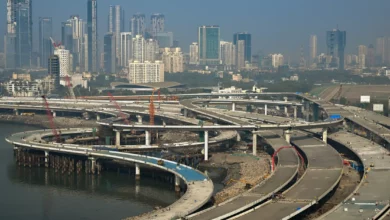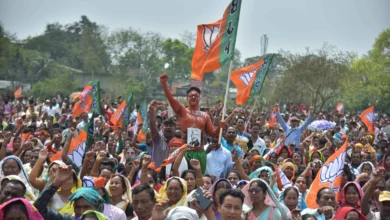
BRISTOL, UK — In a museum room with parquet and expensive flowery wallpaper — dark blue, soft, shiny — the singsong sound of a woman’s voice penetrates from a distance, like a radio providing background noise in a film. It comes from a pole seesawing on its stand as two microphones, one at each end, go up and down.
This roped-off contraption is part of Indian artist Shilpa Gupta’s 2008 work “In Our Times.” The words are not very clear, but are repeated in two photocopies pinned to the wall nearby.
They are two speeches from just after a 1947 British act of parliament: the Indian Independence Act, which created India and Pakistan along the lines of prevailing religions.
One is Mohammad Ali Jinnah’s presidential address to the Pakistani Constituent Assembly.
“We can make this constituent assembly an example to the world,” he says, expressing his hope that bribery, corruption, nepotism and religious discrimination would be tackled, and Pakistan would become one of the greatest nations in the world.
The other is former Indian Prime Minister Jawaharlal Nehru’s speech marking Indian independence. We shall endeavor, he says, to “build up a prosperous, democratic and progressive nation, and to create social, economic and political institutions which will ensure justice and fullness of life to every man and woman.”
“And to India,” he concludes, as though India were one person, “our much-loved motherland, the ancient, the eternal and the ever-new, we pay our reverent homage and we bind ourselves afresh to her service.”
A blurb on the wall says: “The microphones become mouthpieces for a new order, one born of idealistic dreams but which brought terrible violence and losses in its wake.”
In the room, there are also miniature Indian and Mughal watercolors from the 17th and 18th centuries, and works by Imran Qureshi and Shahzia Sikander, both contemporary Pakistani artists interested in miniatures.
In the next room is “A Season Outside” by Amar Kanwar, a gripping video following a line of thought on borders, violence and pacifism. It starts off with activities around the Indian-Pakistan border: heavy loads being passed from the heads of workmen on one side of a white line on the ground to the heads of those on the other, and ostentatious military displays for crowds from each side as the gate is closed for the night.
“Obviously I’m trying to understand the dynamics of division, and in turn find a method for dealing with conflict,” Kanwar tells us in the voiceover.
He quotes Mahatma Gandhi speaking in 1920: “Honestly striving after truth will differ in every case, that is why, sir, the nonviolence part was a necessary corollary.”
“What happens if you start arming your truth?” Kanwar asks, and as birds take turns pecking a small puppy on the screen, he wonders if “when provoked to the very end, when justice is continually denied, and when your dignity is at stake, then comes the moment to arm your truth.” He proceeds to elaborate his changing ideas on the use of violence and pacifism.
These works are part of an exhibition called “No borders: contemporary art in a globalized world” at the council-run Bristol Museum and Art Gallery, a big Edwardian building with an early airplane hanging in its two-story entrance lobby, and ancient Egyptian, Assyrian and Chinese artifact departments, European art collections, and a natural sciences section that includes dinosaurs.
“No borders” is a collaborative project by that institution and the publicly funded Arnolfini contemporary art center. It is part of a collection of international art called “Reflections and Interactions” bought with money from Art Fund International.
“The Art Fund International collection in Bristol takes the city museum’s historic collections from Africa, China and the Middle East as its starting point and, at the same time, seeks to consider Bristol’s history as a port city and site of international trade and exchange,” the Arnolfini website says.
As a port city, Bristol is known for its part in the transatlantic slave trade, a well as for radical religious and political ideas. From around the 1670s until the Slave Trade Act of 1807, ships from Bristol would take supplies to Africa, exchange them for slaves to sell in the Americas, and return with goods such as sugar and tobacco.
“Using the traditional damask walls of the art galleries as a backdrop, the exhibition is an intervention in the museum building,” the exhibition leaflet says, explaining that “gallery spaces are not neutral… Interventions in the museum seek to make the structures that shape meaning apparent.”
Underneath the airplane, next to the Ancient Egypt department, hang large, spacious photographs of transitional areas in Egypt, like buildings sites, from Hala Elkoussy’s work “Peripheral Landscapes.”
There is also work by Akram Zaatari, Yto Barrada and Walid Raad, all members of the Arab Image Foundation — a nonprofit in Beirut that collects, preserves and studies photographs from the Middle East, North Africa and the Arab diaspora.
On display is also Chinese artist Ai Wei Wei’s “A Ton of Tea,” a cube with a hard shiny surface, layers in it like the earth, and a comforting tea smell. There are some small, very smooth, decisive yellow paintings of cartoonish men by Iranian-American artist Tala Madani, and a large installation by South Korean artist Haegue Yang called “Holiday for Tomorrow.”
While updating the museum’s collection and showing interesting works from far off places is important, there seems to be a gap between the show and its claims.
It doesn’t deal with Bristol’s history as a port city. It is not really an intervention that highlights the gallery’s lack of neutrality. And the information it provides on how the choices of Britain and its citizens relate to the mostly unhappy circumstances shown in the works is patchy.
As background on the partition of India, an exhibition leaflet does explain that Britain “exploited India’s resources, made English the official language and suppressed local culture,” and, in relation to Zwelethu Mthethwa’s “Untitled (Sugar Cane Cutters)” photographs, that South African apartheid originated in “racism under the British colonial rulers.” But when the Lebanese Civil War is brought up, the legacy of the French and British mandates in the Middle East is not mentioned, and when discussing China’s Cultural Revolution, the country’s preceding “century of humiliation,” which started with the First Opium War — when the British purposefully got Chinese people addicted to opium to create a market for the smokable opium it manufactured in India — is omitted.
The show does make reference to the global wealth gap (when talking about Barrada’s photographs of economic migrants lying, faces covered, in Tangiers parks) and to “our histories and the economic system that increasingly dominates the world.”
But it might be interesting, and less exotic, if the show was framed in a way that more directly tackled subjects such as why Britain can afford to buy international work for the edification of its populace, whereas Egypt, for example, cannot, and how that fact might relate to how Britain was able to buy Ancient Egyptian artifacts that Egypt could not hold on to.
This piece was originally published in Egypt Independent's weekly print edition.




